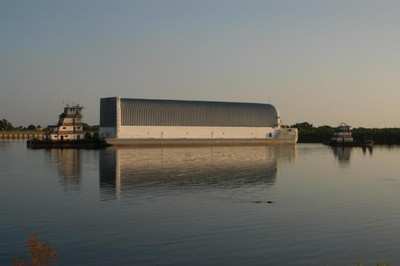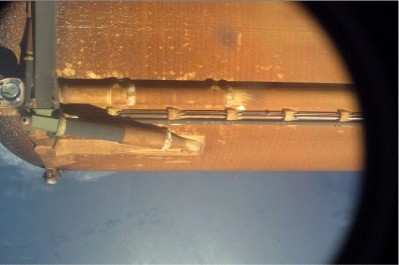Thu, Sep 29, 2005
Michoud Has Recovered Enough To Start Research On STS-114 Foam
Loss
Less than a month after being hit by Hurricane Katrina, NASA's
Michoud Assembly Facility in New Orleans is gearing up to restart
processing space shuttle fuel tanks. The work will address foam
loss during Space Shuttle Discovery's launch in July.

External tank #119, which is expected to be used in the next
shuttle mission, departed NASA's Kennedy Space Center in Florida
today. The huge, orange external tank is being transported by
NASA's solid rocket booster retrieval ship Freedom Star. It will
travel down Florida's Banana River en route to the Gulf of
Mexico-Mississippi River outlet on its 900-mile journey. It's
expected to arrive at Michoud in four or five days.
"The facility is ready to receive the tank and the Michoud team
is eager to get their hands on it," said External Tank Project
Manager Sandy Coleman. Michoud workers will begin limited testing
on the tank as soon as it arrives. Hurricane recovery efforts at
the facility have progressed better than anticipated. Power has
been restored to the entire Michoud complex, and temporary repairs
have been made to damaged buildings. External tank #120 will be
shipped from Kennedy to the facility in the next few weeks.
The external tank, 27.6 feet wide and 154 feet tall, is the
largest element of the shuttle system, which also includes the
orbiter, main engines and solid rocket boosters. Despite the tank's
size, its aluminum skin is only one-eighth-inch thick in most
areas, but withstands more than 6.5 million pounds of thrust during
liftoff and ascent. The tank is the only shuttle component that
cannot be reused.

During a launch, the external tank delivers 535,000 gallons of
liquid hydrogen and oxygen propellants to the three main engines,
which power the shuttle to orbit. The tank is covered by
polyurethane-like foam, with an average thickness of about one
inch. The foam insulates the propellants, keeps ice from forming on
the tank's exterior and protects its aluminum skin from aerodynamic
heat during flight.
The Space Shuttle Propulsion Office at NASA's Marshall Space
Flight Center manages the tank project. Lockheed Martin Space
Systems Co., New Orleans, is the primary contractor.
More News
Aviation Governance Secured...At Least For a While The National Business Aviation Association similarly applauded the passage of the FAA's recent reauthorization, contentedly recou>[...]
Emphasis On Growing The Future of Aviation Through Concentration on 'AFFORDABLE FLYERS' It's been a number of years since the Latest Edition of Jim Campbell's HUGE SportPlane Resou>[...]
Amazilia Aerospace GmbH, Develops Digital Flight Control, Flight Guidance And Vehicle Management Systems Textron eAviation has acquired substantially all the assets of Amazilia Aer>[...]
Honeywell's Primus Brings New Tools and Niceties for Hawker Operators Hawker 4000 business jet operators have a new installation on the table, now that the FAA has granted an STC f>[...]
Company Celebrates Niche-but-Important Advancement in Industry Standards Echodyne has announced full integration of its proprietary 'EchoFlight' radar into the e American Aerospace>[...]
 Bolen Gives Congress a Rare Thumbs-Up
Bolen Gives Congress a Rare Thumbs-Up The SportPlane Resource Guide RETURNS!!!!
The SportPlane Resource Guide RETURNS!!!! Buying Sprees Continue: Textron eAviation Takes On Amazilia Aerospace
Buying Sprees Continue: Textron eAviation Takes On Amazilia Aerospace Hawker 4000 Bizjets Gain Nav System, Data Link STC
Hawker 4000 Bizjets Gain Nav System, Data Link STC Echodyne Gets BVLOS Waiver for AiRanger Aircraft
Echodyne Gets BVLOS Waiver for AiRanger Aircraft




